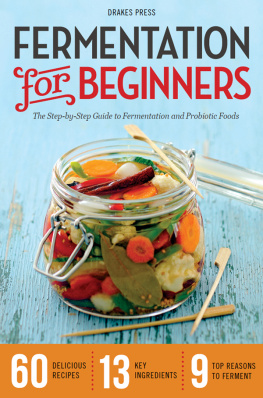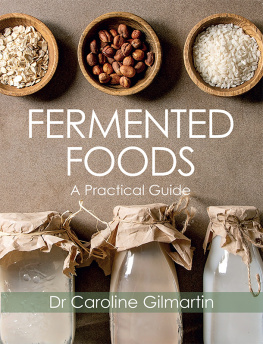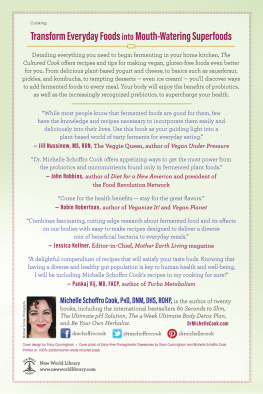Enhance Your
Health with
FERMENTED
FOODS

Warren Jefferson


2015 Warren Jefferson
All rights reserved. No portion of this book may be reproduced by any means whatsoever, except for brief quotations in reviews, without written permission from the publisher.
Cover and interior design: Scattaregia Design
Healthy Living Publications,
a division of Book Publishing Company
PO Box 99
Summertown, TN 38483
888-260-8458
bookpubco.com
ISBN: 978-1-57067-323-8
20 19 18 17 16 15 1 2 3 4 5 6 7 8 9
Library of Congress Cataloging-in-Publication Data
Jefferson, Warren.
Enhance your health with fermented foods / Warren Jefferson.
pages cm
Includes bibliographical references.
ISBN 978-1-57067-323-8 (pbk.) -- ISBN 978-1-57067-873-8 (e-book)
1. Probiotics. 2. Fermented foods--Health aspects. I. Title.
RM666.P835J44 2015
613.26--dc23
2014046265
Printed on recycled paper
Book Publishing Company is a member of Green Press Initiative. We chose to print this title on paper with 100% post-consumer recycled content, processed without chlorine, which saved the following natural resources:

For more information on Green Press Initiative, visit www.greenpressinitiative.org . Environmental impact estimates were made using the Environmental Defense Fund Paper Calculator. For more information, visit papercalculator.org .
CONTENTS
Introduction
If you enjoy eating foods such as dill pickles, sauerkraut, and yogurt or sipping a glass of wine, youre experiencing the pleasures of fermented foods and beverages. At the same time, though you may not realize it, youre getting many important health benefits.
Humans have been consuming fermented foods and drink for at least ten thousand years. We know this because of the discovery in China of a large cache of pottery jars from the Neolithic period. Many of the jars contained a residue that turned out to be the ancient remnants of a fermented beverage made of grapes, honey, rice, and the fruit of the hawthorn tree. But it wasnt until about 150 years ago that scientists discovered that microscopic organisms called microbes were responsible for fermentation.
Microbes have populated the earth for at least 3,500 billion years, as evidenced by fossils found in rocks from that time. Microbes perform essential functions that maintain the health of the biosphere and all living creatures. Theyre also an integral part of the web of life and death, responsible for breaking down plant matter, dead animals, and waste products. The resulting end products are simple substances that then become the building blocks for other life.
Inside and out, our bodies are covered with microbes. We couldnt exist without the beneficial relationship we have with them. However, although we cant live without them, they can live without us quite well.
The microbes that inhabit our intestines are particularly important. The intestinal microbiota, as the flora in the intestines is called, is now considered an essential organ, just like the heart or liver. The microorganisms that make up the intestinal microbiota are involved in digestion, immune cell development, pathogen resistance, and other important body processes. Outside the body, some of the same microorganisms are key players in producing the myriad forms of fermented foods that nourish people throughout the world.
The fermentation of food is all about manipulating microorganisms to achieve a desired food product. A notable group of bacteria is lactic acid bacteria, which is responsible for producing the most fermented food in tons per year and the greatest variety of fermented foods, either independently or in concert with other microorganisms. Certain strains of lactic acid bacteria are the predominant species that make up intestinal flora, and they are included in most probiotic supplement formulas, which are used to boost the number of beneficial microbes in the digestive tract.
Microbes include bacteria, molds, and yeasts, many of which are beneficial and safe to consume. These microbes produce enzymes that are essential to the natural process of fermentation. Enzymes break down foods and other substances into simpler compounds and nutrients. Alcohol and acids are the two primary end products of fermentation, and since most of the microorganisms responsible for spoiling food cannot survive in alcoholic or acidic environments, fermentation is an effective and efficient method of food preservation. In addition, fermentation enhances foods nutritional value, increases its digestibility, and alters its aroma, flavor, and texture in agreeable ways.
Its easy to imagine how fermented foods found their way into human diets. In temperate and tropical regions, our early ancestors would surely have come upon rotting or fermenting fruits and vegetation. Through trial and error, they would have discovered that some were edible and pleasing to the palate. They also would have observed that drinking the juice of fermenting fruit produced profound mind-altering effectsit would get them highand so people were evermore hooked on fermented drinks. Some archaeologists theorize that one of the main reasons early humans settled down and started to farm was to ensure a constant supply of alcoholic beverages. In fact, in addition to bread, wine and beer are thought to be the first fermented products made by man.
Fermented foods are consumed worldwide, and every region has its own particular version, determined by the raw materials available and the natural microbes living there. For example, in North America, were familiar with beer, cucumber pickles, hard cider, sauerkraut, and wine, but countless different kinds of fermented foods and beverages are produced around the world. Fermented foods play a significant role in helping to meet the nutritional needs of the earths population; in fact, fermented foods account for almost one-third of all food consumed globally.
In the following pages youll learn about the different types of fermented foods from around the world and the microbes that produce them. Youll also discover the many benefits of fermented foods and some potential concerns you should be aware of. And youll find simple instructions for how to easily make some fermented products, such as cucumber pickles, rejuvelac, and sauerkraut, at home.
In the past twenty-five years there has been renewed interest in fermented food products and their nutritional and therapeutic properties. Developments in microbiology and fermentation technology continue to evolve. New techniques, such as using more concentrated mediums, result in higher yields and rapid production that relies on less oxygen. The ancient technique of fermentation is, at long last, becoming new and improved, although traditional methods remain as successful as ever.
So read on. Youre about to enter the amazing world of microbes and delicious fermented foods.
A Fermented Superstar: Sauerkraut
Sauerkraut is an enzyme-rich living food containing millions of friendly bacteria. Its low in calories, highly nutritious, and contains vitamins B and C. For a sauerkraut recipe, see . When buying commercially produced sauerkraut, choose a brand thats not pasteurized. The high temperatures reached during pasteurization kill the friendly bacteria.









